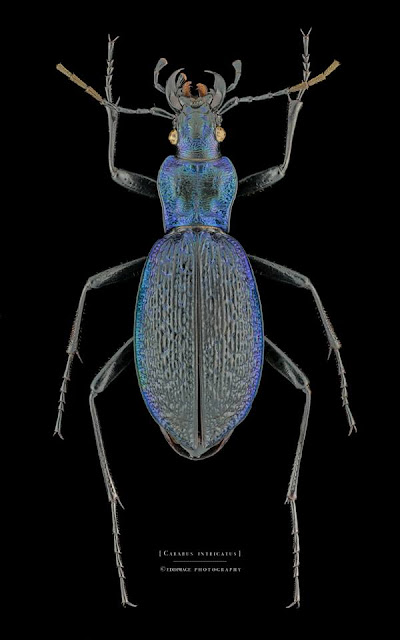Rare Belgian Carabidae: Carabus intricatus
Recently I had the opportunity to take some days off at work. I decided to do some collecting in the Ardens, the last big patch of woodlands in Belgium. The hunt was mainly for Cetoniidae, but as the woodlands were I hiked were too intesively managed, none were to be found.
 |
| Carabus intricatus female, by Eduard Florin |
In the area were I grew up, a similar looking beetle is abundantly present: Carabus violaceus.
C. violaceus also has blueish colours and black elytrae. But unlike the beetle I caught, violaceus has smooth wingcovers. Not sure of my identification I turned to a facebookgroup to find out the correct species name of the beetle. I was quickly helped by a friend who identified this beetle as Carabus intricatus.
The genus Carabus are carnivorous beetles. They hunt snails, earthworms and other small invertebrates. There are few records of Carabus beetles feeding on weak amphibians too!
The species complex has been extensively studied. Due to many Carabus species being very picky about certain habitat types, these beetles are often used as indicator for habitat-type, quality and diversity
In Belgium Carabus intricatus is an indicator of warm, moist beech and oak forest, with deep humus layers. The prefered habitat-type of this beetle varies over it's range. In Switserland for example this beetle is associated with warm and dry pine-forests. Very different from what it likes in Belgium.
Turning to some books and papers about Carabus, the beetle I caught turns out to be very rare in Belgium. Carabus intricatus is present in north-western and central Europe. Since the 1930's the population of the beetle diminished quickly in north-western Europe. The reason for this decline is still unknown, allthough usual factors like climate change, habitat fracturing and intensive forest management are highly likely to be involved.
In the Netherlands this beetle is probably extinct. The last valid observation happened in 1906.
In Flanders some observations happened until the1980's near the Flanders/Netherland border. There is knowledge of some smaller populations in the Ardens area.
On the Belgian website of wildlife observation there are only 11 records in 13 years for Carabus intricatus. All these observations happened in or around the Ardens area. It wasn't known from the locality were I collected this beetle.
For comparison, Carabus violaceus has been spotted 567 times in the same period, and is present over almost all of Flanders and Wallonia.
Due to the few observations and declining population, Carabus intricatus is marked as very rare in Belgium. In central-Europe this species is abundant and not threatened.
Given I only keep a dead collection of my captive-bred beetles, I released this one back to the wild.
(in my opinion, collecting this beetle for a dead collection would be unethical).
Let's hope this Carabus can hunt in these beech forests for some more years.
Below a picture of the habitat and of the beetle I caught.
Off to the next adventure :)






Comments